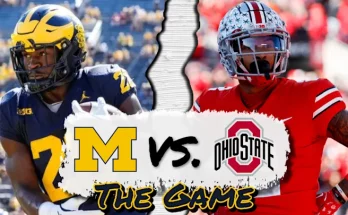Ohio State football carries with it an aura that stretches far beyond the confines of Columbus. Generations of Buckeye teams have been measured not only by their records, not only by their talent, but by the weight of expectation that comes with donning the scarlet and gray. Every new fall brings with it the hum of history, the comparisons to past teams, the chatter about what could be. Yet in the wake of the 2024 season, when Ohio State climbed to the mountaintop and was crowned national champion, head coach Ryan Day has worked tirelessly to make sure one important message resonates within his locker room and outside it: the 2025 team is not the defending national champions—it is the 2025 Buckeyes. That distinction may seem like a mere play on words, but in truth it is a philosophy Day believes could determine whether his program sustains its excellence or succumbs to the weight of yesterday’s glory.
Day has lived long enough inside the high-pressure world of college football to know the dangers that come with leaning on laurels. He understands how often teams fall into the trap of assuming that past success guarantees future achievement, how easy it is for players to believe the crown on their heads is permanent. For Day, the lesson is simple: the 2024 championship was a moment for those players, those leaders, and that version of the Buckeyes. This season, everything resets. The scoreboard is back to zero. New players, new challenges, and new opponents await, each eager to prove they can topple the team everyone has circled on their schedule. In Day’s view, calling his roster the “defending champions” suggests they are somehow in possession of something that can be carried over. But the reality, as he reminds his players, is that nothing has been won in 2025. All that matters is the next play, the next Saturday, and the relentless pursuit of getting better.
There’s a deep psychological wisdom in this stance. Teams that cling to titles often struggle with complacency. Players who bask too long in the spotlight of a parade or a ring ceremony sometimes fail to prepare with the same hunger that fueled their previous rise. By separating this year’s Buckeyes from last year’s triumph, Day is creating a mental environment where nobody can hide behind past success. Every starter must re-earn his role. Every backup must fight to climb the depth chart. Every practice rep must be treated with the urgency of a fresh pursuit. It’s not about defending a title; it’s about attacking a new one. This mindset instills accountability while also shielding his younger players from being smothered by comparisons to legends who came before them.
Still, there is no denying the spotlight shines even brighter when a team is coming off a national championship. The Buckeyes are not stepping onto the field unnoticed. Every opponent will bring its best game, knowing that a victory over Ohio State could define their own season. Rivalries already intense—like Michigan, Penn State, or Wisconsin—will carry even sharper edges now. Even mid-tier Big Ten programs, often overshadowed, will play with desperation, seeing an opportunity to catch Ohio State off guard. This is why Day’s insistence on a clean slate matters. The 2025 Buckeyes cannot approach these games with entitlement; they must embrace the grind as though they are still chasing the crown rather than holding it.
The roster itself reflects the unique blend of continuity and change that makes college football so captivating. Some stars from last year’s run have departed for the NFL, leaving leadership voids that must be filled. The veterans who remain are tasked not just with producing on the field but also with setting the tone in the locker room, modeling the work ethic that Day demands. Meanwhile, younger players, some fresh out of high school, now face the reality of high-stakes college football. For them, the challenge is twofold: learning the system while also carrying the pressure of being on a team expected to contend for everything. Day’s philosophy helps unify these groups by reminding everyone that they are part of a new story, not a sequel. Their names will be etched in history only if they write it themselves.
Fans, of course, play a role in the narrative. Buckeye Nation is known for its passion, for filling Ohio Stadium with over 100,000 voices, for traveling across the country to support their team. But fans also carry expectations, sometimes unfairly conflating one year with the next. Many will demand nothing less than another national title, as though the program is owed perpetual dominance. Day must manage this external pressure while insulating his players from it. He cannot stop the comparisons or the headlines, but he can control the culture inside the Woody Hayes Athletic Center. That is why he repeats his mantra: this is the 2025 team, not last year’s champions. It is a way of setting boundaries between the noise outside and the work within.
The psychology of sports is filled with stories of dynasties undone not by lack of talent but by erosion of focus. Think of teams across different sports that won a championship, only to stumble the following year because the hunger wasn’t the same. Day is determined to prevent that fate. He wants his players to approach every lift in the weight room, every film session, every practice drill as if they are still trying to prove themselves. Complacency is the enemy, and the only way to beat it is to refuse to carry last year’s trophies into this year’s battles. For Day, the words “defending champions” risk creating a cushion where none should exist. He prefers to keep his team sharp by convincing them that they are hunters, not hunted.
This philosophy also reflects the modern realities of college football. With the transfer portal, NIL opportunities, and constant roster turnover, teams are less stable than they were decades ago. Each season truly is a new team with a new identity. The 2025 Buckeyes may wear the same colors as their predecessors, but they are shaped by different personalities, different circumstances, and different challenges. Day’s recognition of this fact shows an adaptability that has helped him thrive as a coach. Rather than clinging to tradition in a rigid way, he adapts his message to the reality of the times, making sure his players understand that their journey is their own.
The Big Ten landscape itself is shifting, with realignment bringing in new opponents and changing the stakes of certain games. Ohio State’s margin for error is slim. A single slip can alter playoff hopes in this era of expanded competition. Day knows that to survive such a gauntlet, his team must approach every week with a fresh mindset. He does not want them to feel burdened by defending anything. Instead, he wants them focused on attacking what lies ahead. The difference between defending and attacking may seem subtle, but in sports psychology, it often means the difference between playing timidly and playing boldly.
Critics may argue that such semantics don’t change the reality—that Ohio State is, in fact, the defending champion until proven otherwise. But Day’s message isn’t about literal truth; it’s about creating a psychological advantage. If his players internalize the idea that nothing has been won yet, they are more likely to train and prepare with the desperation of underdogs. And in college football, where parity is increasing and every edge matters, that desperation could be the key to repeating success.
For the players, embracing this message means reshaping their identity. They cannot live in the shadows of last year’s heroes. They must find their own voices, their own legacies. A wide receiver may be stepping into the role once held by a first-round draft pick, but he cannot afford to think of himself as a replacement. He must see himself as the standard-bearer of 2025. A defensive lineman cannot rest on the reputation of last year’s unit; he must forge his own dominance. Each player has to embrace the responsibility of building a team from the ground up, even if the program’s reputation suggests otherwise.
In the end, Ryan Day’s insistence that this is the 2025 team, not the defending champions, is about more than words. It is about discipline, humility, and the relentless pursuit of excellence. It is about teaching young men that past accomplishments do not guarantee future victories, that greatness must be re-earned every day. It is about instilling the mindset that separates dynasties from one-hit wonders. Whether the Buckeyes succeed in capturing another title remains to be seen, but one thing is clear: Day is determined that his players will not lose sight of what matters most. They are not defenders of yesterday’s crown. They are seekers of tomorrow’s. And in that mindset, perhaps, lies the secret to sustaining Ohio State’s place atop college football’s mountain.



